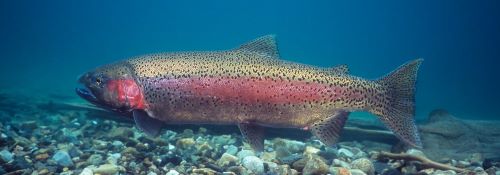The legendary Gerrard rainbow trout has instilled a devout respect in any angler lucky enough to experience one of these fish on the end of their line. Gerrards are renowned for their massive size – frequently exceeding nine kilograms (20 pounds) – as well as their long screaming runs, tail-walking acrobatics, and tireless fight. Until recently, the question remained: are these fish genetically distinct, or are they just a product of their environment? This question was put to the test as part of a large multi-year initiative to better understand and recover the collapsed kokanee population in Kootenay Lake, a large inland lake in southeastern British Columbia.
Gerrard trout are named after a small community on Trout Lake at the head of the Lardeau River, which flows into Kootenay Lake. Incredibly, these fish, which have generated such awe over the generations, are believed to originate from just one short 300-metre-long spawning stretch of the Lardeau.
Trout populations evolved to take advantage of available food
Rainbow trout populations have evolved in many different ways to take advantage of food available to them. Stream and small-lake populations are often insectivorous or planktivorous: they feed at or near the surface of the water on terrestrial insects that drop onto the water, aquatic insects (including nymphal stages), and other plankton like small crustaceans (e.g. mysid shrimp). These fish have smaller mouths adapted to feed on tiny food items. Despite their relatively small size, insectivorous trout can be eager to bite and feisty to fight – providing great angling in many of the province’s streams and small monoculture lakes (where trout are a lake’s only fish).
A rainbow trout population that has regularly been exposed to prey like minnows, kokanee, and other juvenile salmonids may take advantage of a piscivorous (fish-eating) lifestyle. Such a steady, high-protein diet enables trout to grow much bigger; their mouths are larger, enabling them to engulf sizeable prey more efficiently. In a handful of big lakes in British Columbia with reliable populations of kokanee, piscivorous rainbow trout can provide outstanding trophy fishing. And nowhere is this more evident than in Kootenay Lake, where the Gerrard resides.
Large rainbow trout disappeared following kokanee collapse
Starting in 2013, Kootenay Lake suffered a massive decline in kokanee. This collapse was driven by overabundant Gerrards and Bull Trout, and kokanee numbers have yet to recover. Biologists knew that kokanee were a favoured food of the large-bodied Gerrards in the lake. Large rainbow trout also disappeared from the lake’s fishery, but large numbers of small rainbow trout were still evident.
Were the latter just small Gerrards waiting for the opportunity to feed on kokanee again to reach their fabled size, or were they insectivores coming from the numerous small streams around the lake? Could we tell Gerrards apart genetically from the insectivores that we know inhabit the numerous small tributaries of Kootenay Lake?
Gerrard rainbow trout genetically distinct
In 2017, with support from the Freshwater Fisheries Society of BC, provincial biologists collected DNA samples from 19 streams around the lake that were known to produce insectivores. They compared them to DNA samples from historically collected large-bodied trout in the lake fishery, and trout spawners in the Lardeau River. These samples were sent to the University of British Columbia for DNA analysis. The known Gerrard and large-bodied trout samples turned out to be genetically unique compared to all the insectivores. The DNA evidence confirmed that these fish are indeed more than just a product of their environment: they are genetically distinct.
DNA confirms Gerrard rainbow trout still abundant
Biologists then collected DNA samples from the current lake fishery (which is mostly made up of numerous small-bodied trout) to see what the composition of the fishery was. Amazingly, the lake fishery was still made up mostly of the genetically distinct Gerrard rainbow trout; they just happened to be small now that they were feeding mainly on mysid shrimp instead of kokanee. While trophy fish may be uncommon at the moment due to the lack of kokanee in their diet, the numbers of Gerrard trout in the lake appear to be abundant, and its population is currently not a conservation concern.
Using DNA techniques to differentiate Gerrards from other rainbow trout species in the lake’s fishery will allow biologists to track any changes in their population during this important recovery initiative for kokanee and other fisheries in Kootenay Lake.
Author: Sue Pollard, Freshwater Fisheries Society of BC
